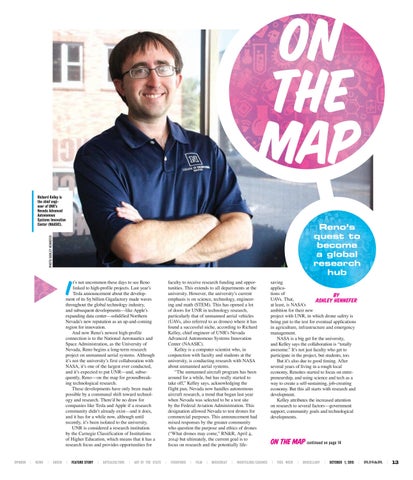ON THE MAP Richard Kelley is the chief engineer of UNR’s Nevada Advanced Autonomous Systems Innovation Center (NAASIC). PHOTO/ASHLEY HENNEFER
Reno’s quest to become a global research hub
I
t’s not uncommon these days to see Reno linked to high-profile projects. Last year’s Tesla announcement about the development of its $5 billion Gigafactory made waves throughout the global technology industry, and subsequent developments—like Apple’s expanding data center—solidified Northern Nevada’s new reputation as an up-and-coming region for innovation. And now Reno’s newest high-profile connection is to the National Aeronautics and Space Administration, as the University of Nevada, Reno begins a long-term research project on unmanned aerial systems. Although it’s not the university’s first collaboration with NASA, it’s one of the largest ever conducted, and it’s expected to put UNR—and, subsequently, Reno—on the map for groundbreaking technological research. These developments have only been made possible by a communal shift toward technology and research. There’d be no draw for companies like Tesla and Apple if a research community didn’t already exist—and it does, and it has for a while now, although until recently, it’s been isolated to the university. UNR is considered a research institution by the Carnegie Classification of Institutions of Higher Education, which means that it has a research focus and provides opportunities for
OPINION
|
NEWS
|
GREEN
|
FEATURE STORY
|
ARTS&CULTURE
|
ART OF THE STATE
faculty to receive research funding and opportunities. This extends to all departments at the university. However, the university’s current emphasis is on science, technology, engineering and math (STEM). This has opened a lot of doors for UNR in technology research, particularly that of unmanned aerial vehicles (UAVs, also referred to as drones) where it has found a successful niche, according to Richard Kelley, chief engineer of UNR’s Nevada Advanced Autonomous Systems Innovation Center (NAASIC). Kelley is a computer scientist who, in conjunction with faculty and students at the university, is conducting research with NASA about unmanned aerial systems. “The unmanned aircraft program has been around for a while, but has really started to take off,” Kelley says, acknowledging the flight pun. Nevada now handles autonomous aircraft research, a trend that began last year when Nevada was selected to be a test site by the Federal Aviation Administration. This designation allowed Nevada to test drones for commercial purposes. This announcement had mixed responses by the greater community who question the purpose and ethics of drones (“What drones may come,” RN&R, April 4, 2014) but ultimately, the current goal is to focus on research and the potentially life-
|
FOODFINDS
|
FILM
|
MUSICBEAT
|
NIGHTCLUBS/CASINOS
saving applications of BY UAVs. That, ASHLEY HENNEFER at least, is NASA’s ambition for their new project with UNR, in which drone safety is being put to the test for eventual applications in agriculture, infrastructure and emergency management. NASA is a big get for the university, and Kelley says the collaboration is “totally awesome.” It’s not just faculty who get to participate in the project, but students, too. But it’s also due to good timing. After several years of living in a rough local economy, Renoites started to focus on entrepreneurship, and using science and tech as a way to create a self-sustaining, job-creating economy. But this all starts with research and development. Kelley attributes the increased attention on research to several factors—government support, community goals and technological developments.
ON THE MAP continued on page 14 |
THIS WEEK
|
MISCELLANY
|
OCTOBER 1, 2015
|
RN&R
|
13










